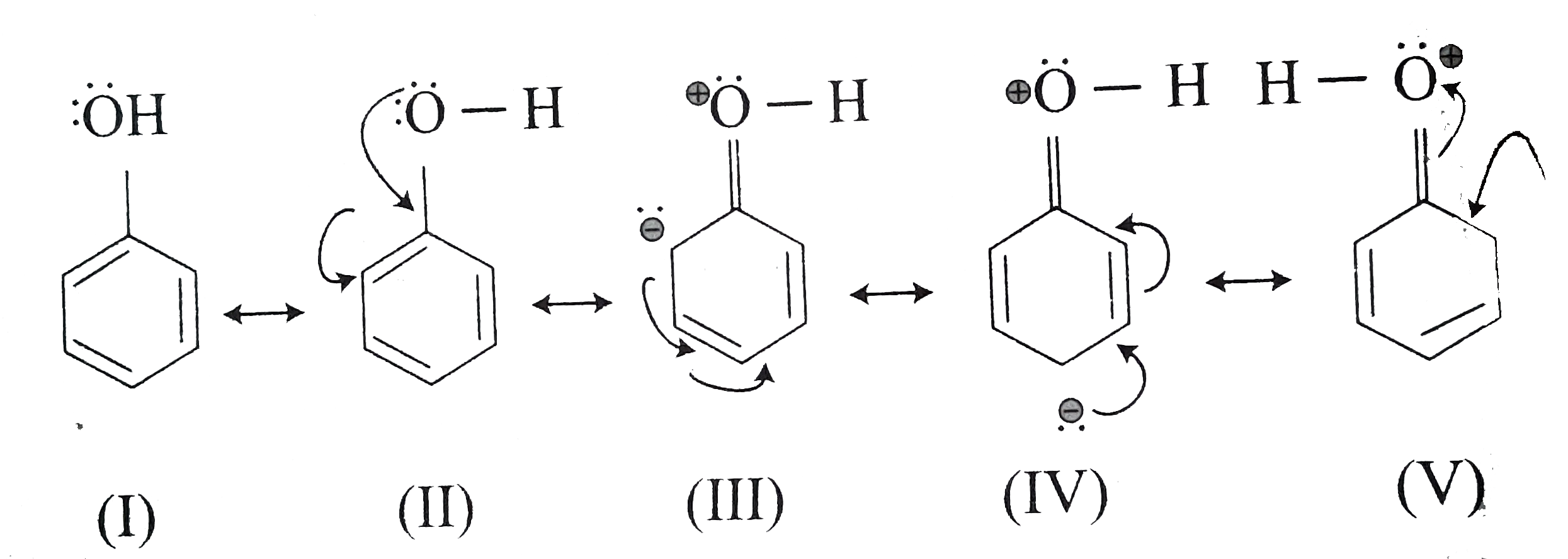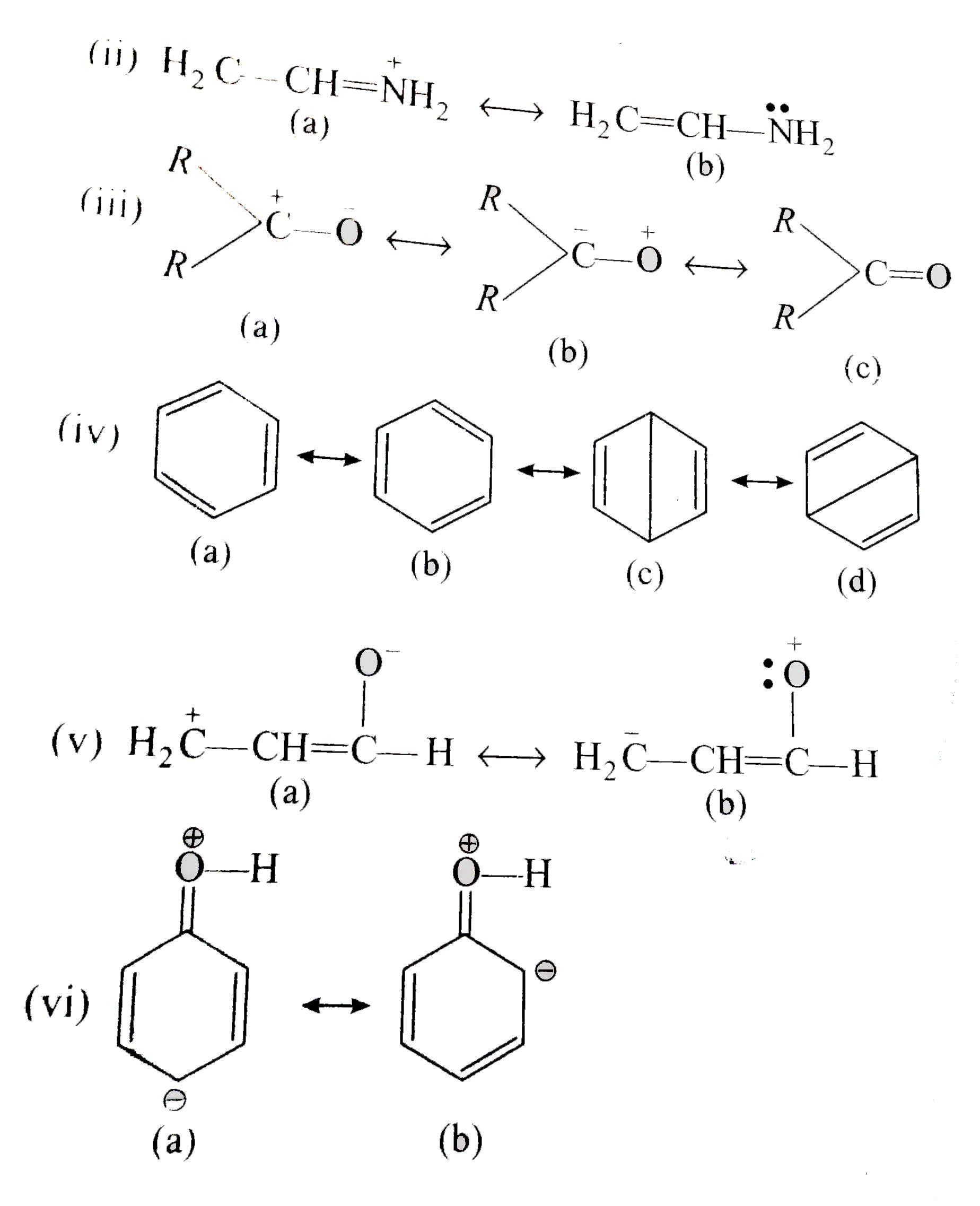Arrange the following resonating structures in the order of decreasing stability :
(a) CH2=CH−..C..I:(I)(Vinyl chloride)↔:ΘCH2−CH=⊕C..I:(II)↔⊕CH2(III)−CH=..C..IΘ
b. H−..O:∣∣C(IV)(Formic acid)−..O..H↔H−:..O:Θ∣C=..O⊕(V)−H↔H−:..O:Θ∣C⊕−..O..−H↔(VI)H−⊕:O:∣C..Θ−..O..−H(VII)
( c) Write the resonating structure of phenol in order of decreasing stability.
(a) (i) is most stable because it has no formal charges.
(ii) (III) is least stable because it has an ¯e−deficient carbon. In (III), C1 uses an empty 3d orbital to accommodate a pair of ¯e,s which is not possible in the C atom. Thus, the order of stability is (I)>(II)>(III)
(b) (i) (IV) and (V) have greater number of convalent bonds , hence, these are more stable than either (VI) or (VII) . Furthermore between (IV) and (V),(IV) has no formal charges and hence is more stable than the (V)
(ii) (VII) is less stable than (VI) because in (VII) the positive charge is on oxygen, which is a more EN atom than carbon on which positive charge is present in (VI). Thus, the order of stability is (IV)>(V)>(VI)>(VII)
( c) In the resonating structure of phenol as shown below, structure (I) and (II) are more stable than the others.
Structures (III),(IV), and (V) are less stable due to charge separation and positive charge on oxygen atom.

Order of stability ⇒(I)=(II)>(III)=(V)>(IV)
(I)and (II) ⇒ Unchanged structures
(IV)⇒ More charge separation
Order of energy ⇒(IV)>(III)=(V)>(I)=(II)
(III)and (V) rArr Less charge separation.
Topper's Solved these Questions
- GENERAL ORGANIC CHEMISTRYBOOK - CENGAGE CHEMISTRYCHAPTER - GENERAL ORGANIC CHEMISTRYEXERCISE - Solved Example
18 Videos
- GENERAL ORGANIC CHEMISTRYBOOK - CENGAGE CHEMISTRYCHAPTER - GENERAL ORGANIC CHEMISTRYEXERCISE - Subjective
11 Videos
- CLASSIFICATION AND NOMENCLATURE OF ORGANIC COMPOUNDSBOOK - CENGAGE CHEMISTRYCHAPTER - CLASSIFICATION AND NOMENCLATURE OF ORGANIC COMPOUNDSEXERCISE - Analytical and Descriptive Type
3 Videos
- HYDROGEN, WATER AND HYDROGEN PEROXIDEBOOK - CENGAGE CHEMISTRYCHAPTER - HYDROGEN, WATER AND HYDROGEN PEROXIDEEXERCISE - Subjective Archive (Subjective)
3 Videos
Similar Questions
Which resonance form in each of the following sets is the major contributor to the real structure?
(i) H2C=CH−..C..I:(a)↔H2−..C−CH=−+C..I:(b)↔H2+C−CH=..C..I:−(c)
(ii) H2−C−CH=+NH2(a)↔H2=CH−..NH2(b)

View SolutionWrite the names of the following compounds :
H−H∣C∣H−H∣C∣H−H∣C∣H−H∣C∣H−O∣∣C−H
View Solution
Knowledge Check
Arrange the following resonating structures of formic acid in order of decreasing stability:
H−O∣∣C−OH(I)↔H−O−∣∣C−+OH(II)↔HO−∣C+−OH(III)↔H−O−∣C−−O(IV)AII>I>III>IVBI>III>II>IVCIII>II>IV>IDIV>III>I>IIArrange the following carbonium ions in order of decreasing stability :
(CH3)3+CI (CH3)2+CHII CH3+CH2III +H3CIVAII>III>I>IVBIV>III>II>ICI>II>III>IVDI>II>III>IVΘ..CH2−C∣∣O−CH3andCH2=C∣:O..:Θ−CH3 are :
AResonating structuresBTautomersCGeometrical isomersDOptical isomers
Write the names of the following compounds :
H−H∣C∣H−H∣C∣H−H∣C∣H−H∣C∣H−O∣∣C−OH
View SolutionIn the following sets of resonating structure, lable the major and minor contributors towards resonance hybrid.
(P)CH3−ΘCH−C≡N(I)↔CH3CH=C=..N:Θ(II) (Q)CH3−ΘCH−CH=CH−NO(I)↔CH3−CH=CH−CH=⊕N∣OΘ−OΘ(II)
(R)CH3−CH2−⊕C∣NH2−NH2(I)↔CH3−CH2−C∣NH2=⊕NH2(II) (S)CH3−O∣∣C−ΘCH−O∣∣C−CH3(I)↔CH3−OΘ∣C=CH−O∣∣C−CH3(II)
View SolutionWhich resonance form in each of the following sets is the major contributor to the real structure?
(i) CH2−C∣CH3−CH(A)=CH2↔+CH2−C∣CH3=CH(B)−−CH2↔−CH2−C∣CH3=CH(C)−+CH2
(ii) CH3−O∣∣C−CH(A)=CH2↔CH3−O−∣C+−CH(B)=CH2↔CH3−O−∣C=CH(C)−+CH2
(iii) CH2=CH−CH=CH2(A)↔+CH2−CH=CH(B)−−CH2↔−CH2−CH=CH−+CH2(C)

View SolutionArrange the following free radicals in order of stability
(CH3)3⋅CI (CH3)2⋅CHII CH3⋅CH2III ⋅CH3IV
View SolutionPh−Ph∣C∣OH−CH3∣C∣OH−CH3+Ph−Ph∣C∣OH−Et∣C∣OH−EtH2SO4−−−→
View Solution
